The 6 Types of Asbestos

November 02, 2023
Asbestos is a natural mineral that develops in various rock formations all over the world, including in the eastern and western U.S. For decades, companies used asbestos in many products, including building materials and household items—even after they knew that all types of asbestos cause serious diseases, including mesothelioma.
How Many Types of Asbestos Are There?
There are six types of asbestos:
- Chrysotile
- Crocidolite
- Amosite
- Tremolite
- Anthophyllite
- Actinolite
They’re all part of the same class of mineral, which is made up of microscopic fibrous crystals, knowns as “fibrils.” Beyond that, the different types of asbestos have different properties, including:
- Color
- Fiber shape and size
- Strength, flexibility and heat-resistance
These varying properties also make them useful for different purposes.
Chrysotile Asbestos
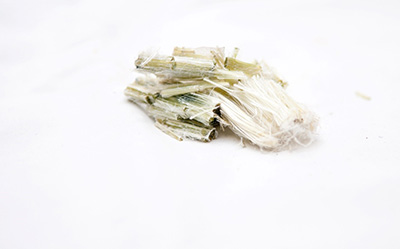
Chrysotile asbestos is the most common type found in asbestos products, especially construction materials. The chloralkali industry, which makes chlorine, also relies on chrysotile asbestos. It’s incredibly useful because it is very strong, has a high resistance to tension and is easy to weave because its fibers are long and flexible.
- Color: White
- Fiber shape: Long and curly
- Uses: Asphalt, auto parts, cement, paper, plastics, sealants, textiles and more
Crocidolite Asbestos

Crocidolite asbestos has thinner fibers than the remaining types of asbestos on this list, but not as thin as chrysotile. It’s flexible and easy to spin and weave, but it has less heat resistance than other types. That means it wasn’t frequently used in products, but it was used in cigarette filters.
- Color: Blue
- Fiber shape: Small, thin and sharp
- Uses: Cement, cigarette filters, insulation, roof tiles, floor tiles and tile adhesive
Amosite Asbestos
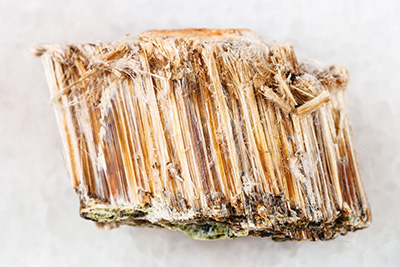
Amosite is the second most used type of asbestos in the U.S. It was mainly mined in South Africa until the last mine closed and stopped producing it in 2002. It has one of the highest levels of heat resistance of all asbestos types, so it was often used in construction materials.
- Color: Brown
- Fiber shape: Long, straight and coarse
- Uses: Ceiling tiles, fireproof materials, gaskets, insulation, pipe fittings, roofing products and steel
Tremolite Asbestos
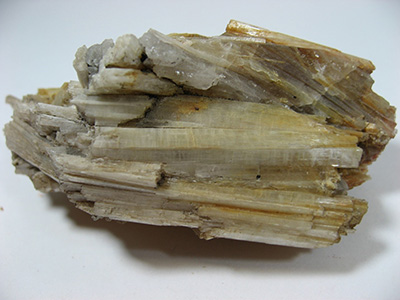
Tremolite asbestos is also called Libby asbestos because it was mined in Libby, Montana. Compared to other types of asbestos, its fibers are more brittle and also more acid-resistant. However, because it occurs in the same rock formations as chrysotile, a more useful asbestos type, tremolite found its way into plenty of products despite its brittle fibers.
- Color: Ranging from white to dark green
- Fiber shape: Long and sharp
- Uses: Attic insulation, paint, roofing tiles, sealants and talc-based products
Anthophyllite Asbestos
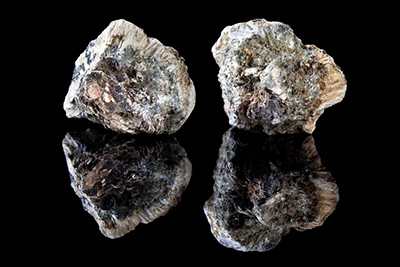
Anthophyllite asbestos is not as common in nature, although it’s sometimes found in talc deposits. It also has short, brittle fibers that aren’t as useful as an additive. That means it’s found in fewer products and materials than other asbestos types.
- Color: Yellow or light brown
- Fiber shape: Short, very brittle
- Uses: Cement, insulation
Actinolite Asbestos
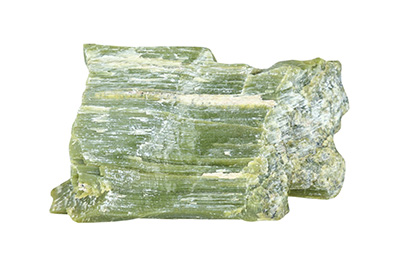
Actinolite is another rare type of asbestos that isn’t often found in consumer products. It’s closely related to tremolite, and contains calcium, iron, magnesium and silicon. It occurs in the same rock formations as amosite, but its fibers are more brittle, so it isn’t as useful.
- Color: Most commonly green
- Fiber shape: Long and sharp
- Uses: Cement, drywall, insulation, paint and sealant
Asbestos in Minerals
Multiple asbestos types often occur together. Because asbestos is a natural mineral, it also occurs in the same places as other minerals. The most common minerals that may be contaminated by asbestos include:
- Talc: This mineral is used in beauty products to absorb moisture, prevent caking and improve smooth application. Tremolite is the most common type of asbestos found in talc deposits, but anthophyllite and actinolite also occur. The fact that these two minerals form together means that makeup with talc can be contaminated with asbestos, as testing has shown. Some consumers choose to avoid talc products for this reason.
- Vermiculite: This mineral is used in packing materials, as well as insulation, concrete and other construction materials. While it’s not dangerous on its own, it may be contaminated with asbestos during the mining process. If your home was built with vermiculite insulation, you’ll want to test for asbestos before renovating.
Health Effects of Asbestos
No amount of asbestos of any type is safe to inhale. The microscopic fibers get stuck in the lung tissue and cause inflammation and scarring. Over time, asbestos exposure can cause diseases like mesothelioma, lung cancer and asbestosis. The more asbestos you were exposed to, and the higher the concentration, the greater the chance you could develop an asbestos-related disease.
Exposure is the biggest predictor of negative health effects, but studies have also linked certain types of asbestos to various diseases. Lung cancer is linked to long, thicker fibers (longer than 10 microns and thicker than 0.15 microns). Mesothelioma is linked to thin, intermediate-length fibers (longer than 5 microns and thinner than 0.1 microns). However, mesothelioma can also be caused by short fibers.
Mesothelioma is a unique illness because it is caused almost exclusively by asbestos. If you or a loved one has been diagnosed with mesothelioma, it’s likely that you were exposed to asbestos. No matter what type of asbestos resulted in the diagnosis—you deserve compensation.
Early, Lucarelli, Sweeney and Meisenkothen can help you investigate your case and hold the right companies responsible. Contact us today for a free case evaluation.
Frequently Asked Questions
How does exposure to asbestos lead to cancer?
When you’re exposed to asbestos dust, you inhale invisible, sharp fibers that become embedded in your lungs. Over time, they cause changes to the tissue, including inflammation and DNA damage that can lead to cancer like mesothelioma. Exactly how this happens isn’t clear, but one study proposed that it may be due to the release of a certain molecule when asbestos fibers kill cells.
Are there any safe uses of asbestos?
No—there are no safe uses of asbestos. All types of asbestos are hazardous when they’re inhaled. While existing insulation, tiles and other materials are safe unless they’re damaged or disturbed, installing and renovating these materials is a health hazard.
What is the most dangerous form of asbestos?
Crocidolite asbestos is the most dangerous type of asbestos because its fibers are very thin and sharp, so they get lodged in the lungs easily. Amosite is also dangerous, for the same reason—but also because it’s more commonly used. And, because it’s the most widely used type, chrysotile asbestos is believed to be responsible for the most illness.
How can I prevent asbestos exposure in my home?
Asbestos exposure in the home most often occurs during repairs and renovations, when you disturb materials containing it, like tile floors, drywall and ceilings. Sanding, drilling and breaking down these materials releases different types of asbestos fibers into the air. To prevent exposure, test any materials installed before the mid-1980s for asbestos and hire a professional contractor.
Request a Free Case Evaluation
Request a free case evaluation now if you or someone you love has been diagnosed with mesothelioma. The evaluation will cost you nothing. Our lawyers will travel to visit you at your convenience or conference call with you over the phone. We understand how difficult a time this is for you and will assist in any way that we can. You can also call us toll-free at 1-800-336-0086 at any time.




